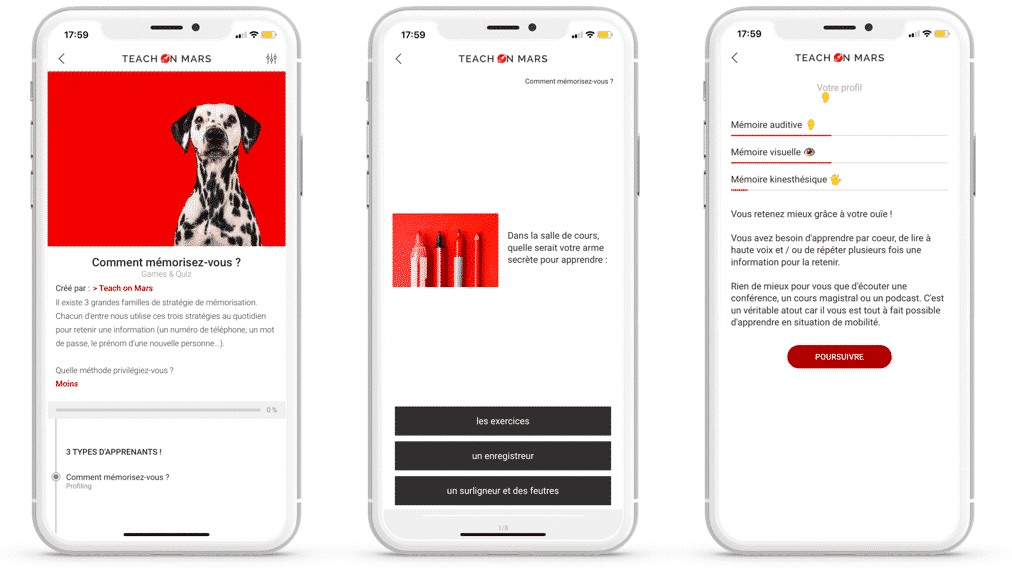It’s been proven time and again: engagement is a key factor in the success of a learning strategy (as in many other things). Today, we’re inviting you to (re)discover one of the Teach on Mars activities that will help you engage your learners at the start of a training course, as well as offering many other pluses – the art of Profiling!
The “Profiling” activity: what exactly is it?
Profiling is one of our engagement activities that aims to make the learner central to their training through use of a questionnaire. For each question, learners choose the option that fits them best. At the end of the activity, they get to see their profile (based on their answers).

The training course “How do you remember?” (on the left), an example of a Profiling question (in the centre) and the resulting profile (on the right).
Different types of profile can be targeted, for example, by defining a level (beginner, intermediate, expert) or a type of personality (influential, shy, curious, etc.). Identifying such profiles will allow you to recommend given modules in a training course.
The virtues of Profiling
As mentioned above, Profiling is primarily an engagement activity that generally occurs at the start of a course. It can allow a designer to:
- Establish the learner’s need for training: To engage certain learners, it’s sometimes essential to go through an awareness-raising phase. “I want to train managers in positive feedback and to do that I need learners to understand that their personality will influence their communication biases.” This Profiling phase encourages the learner to ask questions of themselves… and to look for the answers!
- Guide a learner through their training course: Profiling invites learners to follow the content recommended for them, in line with their level; for example, by suggesting they start their training course at module 3 because the first two modules cover information they already know.
- Make users want to learn by personalising their learning experience: “This training is made for you!”. When they read their profile, learners should understand why a particular course is the right one for them. By creating a profile that allows learners to recognise themselves, you’re helping to actively engage them.
Examples of good Profiling
If you want to see what Profiling looks like at the start of a training course, we have two examples on our Teach on Mars app (free of charge):
- The “How do you remember?” course
- The latest episode of Mars Attacks entitled “Thinking outside the box”

You can access these courses from the Teach on Mars app (free of charge), by scanning the QR codes above (with the app scanner from the add-ons page). Then simply run the Profiling activity!
Already tried it? Leave a comment to tell us about your profile!
How to create a good Profiling activity
For this activity you’ll need:
- a central theme
- at least 2 profiles and a description for each of them
- at least 3 questions per profile, ideally with a total of around ten questions.
That’s all you need to know. Looking for inspiration? Here are some examples of themes and associated profiles:
- What type of manager are you? Directive / Persuasive / Participatory / Delegating
- What is your salesperson profile? Relational / Expert / Advisor / Hunter
- How green are you? ‘Do your bit’ green / Green explorer / Green master
- What type of movie buff are you? Young Padawan / Cinema Jedi / Movie buff Grand Master
As you can see, one of the many advantages of Profiling is that it allows you to engage learners and guide them within a training course. But how do you guide them towards a particular course? If you’re asking this question, the Recommendation Quiz is made for you!
Share your best Profiling themes with us by commenting on this article.
See you soon for our next review of best practices!

D’abord éditrice de manuels scolaires, professeure et coordinatrice pédagogique à l’Université, Julia a rejoint l’équipe Learning Experience chez Teach on Mars pour apporter ses compétences en pédagogie. La gamification et la différenciation pédagogique sont notamment ses chevaux de bataille.




